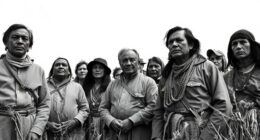The history of Native American tribes is filled with wisdom and full of stories waiting to be unearthed. Join us on this enlightening journey as we explore the top 15 books on Native American history. These books will deepen our understanding and broaden our perspectives.
From the haunting tale of the Osage Murders to the powerful memoir of a Navajo Code Talker, these books promise to transport us to pivotal moments in history and shed light on the rich cultures and struggles of indigenous peoples.
So, buckle up and prepare to embark on an enlightening journey through the pages of these captivating books.
Key Takeaways
- There are books available that focus on specific historical events and figures related to Indigenous history, such as the Osage Murders, Navajo Code Talkers, and the last stand of the Great Sioux Nation.
- Books also explore the mistreatment and oppression faced by Native Americans, as well as the influence of white supremacy and Christian nationalism in America.
- Some books highlight the resilience and cultural richness of Native American societies, including their unique ingredients and flavors.
- Comprehensive representation of Native American history is also addressed in books, discussing advanced civilizations, environmental manipulation, and the overall Native American history and experience.
Killers of the Flower Moon: The Osage Murders and the Birth of the FBI

For those seeking a gripping true crime account that sheds light on America's troubled history with indigenous peoples, 'Killers of the Flower Moon: The Osage Murders and the Birth of the FBI' is the perfect choice.
This book, written by David Grann, delves into the chilling conspiracy that unfolded in the 1920s within the Osage Nation in Oklahoma. The Osage, a Native American tribe, experienced a surge in wealth due to the discovery of oil on their land. However, their newfound prosperity attracted greed and violence.
One by one, Osage family members were targeted and killed, using methods such as shooting and poisoning. As the death toll rose and investigators were also murdered, the newly formed FBI, under the leadership of J. Edgar Hoover, became involved. Texas Ranger Tom White led the investigation, forming an undercover team that included a Native American agent.
This true crime masterpiece uncovers one of the most chilling conspiracies in American history and highlights the disturbing relationship between America and indigenous peoples.
Best For: True crime enthusiasts and readers interested in exploring America's troubled history with indigenous peoples.
Pros:
- Gripping and chilling storytelling that keeps readers engaged from start to finish.
- Provides a deep dive into a lesser-known historical event and sheds light on an important aspect of American history.
- Well-researched and offers a unique perspective with the inclusion of the Native American agent on the undercover team.
Cons:
- Some readers may find the subject matter disturbing or unsettling.
Code Talker: Memoir by Navajo Code Talker of WWII

The gripping memoir 'Code Talker' by a Navajo Code Talker of WWII offers a profound understanding of the Indigenous history that will resonate with readers seeking a firsthand account of the Navajo's crucial contribution to the war effort. This book provides an intimate look into the experiences of Chester Nez, one of the original Navajo code talkers, as he shares his personal trials and losses during the war. Nez's narrative sheds light on the discrimination and punishment he faced for speaking his native language, as well as the resilience and strength he found in Navajo culture.
The book also delves into the creation and effectiveness of the Navajo code, which played a pivotal role in ensuring victory for the United States over Japan in the South Pacific. 'Code Talker' is highly praised for its gripping storytelling and historical significance, making it an essential read for anyone interested in Indigenous history and the untold stories of the Navajo code talkers.
Best For: Readers interested in WWII history and Indigenous history, particularly those seeking a firsthand account of the Navajo code talkers' contribution to the war effort.
Pros:
- Offers an intimate look into the experiences of Chester Nez, one of the original Navajo code talkers.
- Provides insights into the creation and effectiveness of the Navajo code, which played a pivotal role in ensuring victory for the United States over Japan.
- Highly praised for its gripping storytelling and historical significance.
Cons:
- May not delve deeply into the broader historical context of WWII beyond the Navajo code talkers' contribution.
The Earth Is All That Lasts: Crazy Horse, Sitting Bull, and the Last Stand of the Great Sioux Nation

A captivating account of the destruction of the Sioux and their courageous leaders, 'The Earth Is All That Lasts' offers an essential perspective for those seeking a deeper understanding of Indigenous history. This informative book, written by Mari Sandoz, chronicles the devastating impact on the Sioux and their culture. Sandoz skillfully combines Native American oral histories, artwork, and written history to create a comprehensive chronology of the Sioux's downfall. The book is well-documented, with a reference section spanning 125 pages, ensuring that readers have access to thorough research.
It sheds light on the exploitation of bison by Native tribes for trade, which led to a decrease in their population. It also delves into the rise and fall of leaders like Sitting Bull and Crazy Horse, providing a detailed history of their lives and the events that shaped them. 'The Earth Is All That Lasts' also documents the genocide and desperation faced by the Sioux tribes, including the use of strychnine by the Whites to poison them. Despite the Sioux's victory at Little Big Horn, they were relentlessly hunted down during vulnerable winter months.
The book has received positive reviews for its meticulous research and compelling storytelling, although some critics have mentioned excessive detail and a lack of specific battle names. Overall, 'The Earth Is All That Lasts' is a factual and thought-provoking read that deepens our understanding of the plight of the Sioux and their remarkable leaders.
Best For: History enthusiasts, students studying Indigenous history, and individuals interested in learning about the plight of the Sioux and their leaders.
Pros:
- Informative and well-researched, providing a comprehensive chronology of the destruction of the Sioux and their culture.
- Skillfully combines Native American oral histories, artwork, and written history, offering a holistic perspective.
- Engaging storytelling that keeps readers interested in this era of history.
Cons:
- Some critics mention excessive detail, which may be overwhelming for readers looking for a more concise overview.
The Apache and Comanche: History and Legacy of Southwest's Warrior Tribes

Filled with numerous historical facts, this book on the Apache and Comanche tribes is an excellent choice for deepening our understanding of Indigenous history. It sheds light on the historical significance of these tribes and their resistance against white settlers. The book depicts the atrocities committed by the settlers, painting a tragic picture of what happened to these tribes. It also sparks further interest in reading by providing a short history and piquing curiosity with its plethora of facts.
However, the book has its drawbacks, such as its lack of page numbers and poorly done layout. Nonetheless, it offers valuable information for the general reader. The book covers the high spots in the tribes' history, highlighting what made their cultures unique, without portraying settlers or natives as heroes or villains. It also delves into the fear and reputation that the tribes held, explaining the reasons behind it and mentioning their eras of greatness.
Best For: General readers interested in deepening their understanding of Indigenous history.
Pros:
- Filled with numerous historical facts.
- Highlights the historical significance and resistance of the Apache and Comanche tribes against white settlers.
- Sparks further interest in reading with its short history and plethora of facts.
Cons:
- Short book with no page numbers.
An Indigenous Peoples History of the United States (ReVisioning History)

For those seeking a transformative understanding of Indigenous history, 'An Indigenous Peoples History of the United States (ReVisioning History)' offers a comprehensive exploration of the United States' war-filled past, the mistreatment of Native Americans, the resilience of Native American societies, and the need for a critical reevaluation of our collective history. This book delves into the deep-rooted history of war and violence in the United States, highlighting how the country has been engaged in warfare since its inception and how it has shaped the nation's identity. It also uncovers the dark truths of genocide and mistreatment inflicted upon Native Americans, shedding light on the policies and actions that have perpetuated their suffering.
Moreover, the book emphasizes the strength and endurance of Native American societies, showcasing their vibrant cultures, governance systems, and their profound connection to the land. Ultimately, 'An Indigenous Peoples History of the United States (ReVisioning History)' challenges us to reevaluate our understanding of history and confront the painful truths of our past.
Best For: Readers who are interested in gaining a comprehensive and transformative understanding of the United States' history, particularly its war-filled past, mistreatment of Native Americans, and the need for a critical reevaluation of our collective history.
Pros:
- Provides a comprehensive exploration of the United States' war-filled past and the mistreatment of Native Americans, shedding light on often overlooked aspects of history.
- Showcases the resilience and enduring cultures of Native American societies, offering a balanced perspective on their governance systems and profound connection to the land.
- Challenges readers to confront the painful truths of the past and reevaluate their understanding of history.
Cons:
- Some readers may find the content disturbing or unsettling due to the documentation of genocide and mistreatment inflicted upon Native Americans.
The Sioux Chefs Indigenous Kitchen

Winner of the 2018 James Beard Award for Best American Cookbook, 'The Sioux Chef's Indigenous Kitchen' offers a culinary journey that celebrates indigenous American ingredients and flavors. This book takes a unique approach to cooking by focusing on real food made with indigenous fruits, vegetables, wild and foraged ingredients, game, and fish. It embraces locally sourced, seasonal, and 'clean' ingredients, avoiding European staples like wheat flour, dairy products, sugar, and domestic pork and beef. Instead, it highlights venison, rabbit, trout, duck, quail, wild turkey, blueberries, sage, sumac, and many other native ingredients.
The recipes featured in this book range from cedar braised bison to griddled wild rice cakes, showcasing the richness and diversity of indigenous cuisine. 'The Sioux Chef's Indigenous Kitchen' has received praise from renowned publications and individuals, and it has also resonated with readers who appreciate the educational aspect and the opportunity to explore indigenous cooking firsthand.
Best For: Individuals who are interested in exploring and incorporating indigenous American ingredients and flavors into their cooking.
Pros:
- Offers a unique approach to cooking with a focus on real food made with indigenous ingredients
- Emphasizes locally sourced, seasonal, and 'clean' ingredients
- Provides a diverse range of recipes showcasing the richness and diversity of indigenous cuisine
Cons:
- May require some effort to source indigenous ingredients that may not be readily available in all areas
Native American History

Indigenous History Books for Deepening Understanding offers a comprehensive representation of Native American history and culture, providing valuable insight and knowledge for those seeking a deeper understanding of these First Nations peoples. Positive reviews and appreciation for Native American history and culture are highlighted, with readers expressing their enthusiasm for learning about the stories, myths, and traditions of Native Americans. The book is praised for its comprehensive approach, offering real stories and delving into the earliest Native Americans, their cultures, and their myths and legends.
However, some critiques mention that the book lacks depth and fails to fully explore indigenous perspectives. Historical injustices and the call for reparations are also mentioned, with references to the government's campaign to eradicate Native Americans and the need for acknowledgment and compensation. Specific historical events and figures such as the tribes' response to colonialism and notable figures like Wounded Knee and Sitting Bull are discussed.
Overall, the book is appreciated for its informative nature, although some suggest it may be better suited for a high school social studies class.
Best For: Readers who are interested in gaining a basic understanding of Native American history and culture.
Pros:
- Provides valuable insight and knowledge into Native American history and culture.
- Includes real stories, myths, and legends of Native Americans.
- Offers a comprehensive representation of Native Americans and their stories.
Cons:
- Lacks depth and fails to fully explore indigenous perspectives.
History: From the Dawn of Civilization to the Present Day (DK Definitive Visual Encyclopedias)

With its comprehensive coverage and stunning visuals, 'History: From the Dawn of Civilization to the Present Day' is an invaluable resource for anyone seeking a deeper understanding of Indigenous history. This definitive visual encyclopedia takes readers on a journey through time, exploring the origins of human civilization and its impact on Indigenous peoples around the world. The book covers key events, groundbreaking ideas, political forces, and technological advances, providing clear and concise coverage of each historical episode.
It also includes profiles of influential figures, shedding light on their contributions and the role they played in shaping Indigenous history. While some critics mention the lack of depth on certain historical events, the book compensates with its ability to engage readers of all ages. Furthermore, the inclusion of contemporary issues brings the book into the present, allowing readers to connect the dots between the past and the present.
Overall, 'History: From the Dawn of Civilization to the Present Day' serves as a valuable reference tool, providing fast facts and a visually appealing overview of Indigenous history.
Best For: Readers of all ages seeking a visually engaging and comprehensive overview of Indigenous history.
Pros:
- Comprehensive and compelling visual encyclopedia covering key events, political forces, and technological advances in Indigenous history.
- Profiles of influential figures shed light on their contributions and the role they played in shaping Indigenous history.
- Inclusion of contemporary issues allows readers to connect the dots between the past and the present.
Cons:
- Some critics mention the lack of depth on certain historical events.
The Hidden Roots of White Supremacy: and the Path to a Shared American Future

For those seeking a profound understanding of Indigenous history, 'The Hidden Roots of White Supremacy: and the Path to a Shared American Future' delves into the historical connections and the paradox of America's origins, shedding light on the impact of white supremacy and offering a path towards a more inclusive democracy.
This New York Times Bestseller explores the deep-rooted history of white supremacy in America, examining its connections to racial violence and oppression. It highlights the Doctrine of Discovery, a 15th-century church doctrine that justified the colonization and violence against Native Americans. The book also discusses the paradox of America's origins, where a democratic society was built on a foundation of mass racial violence.
By reframing American origins, the author, Robert P. Jones, offers the possibility of a new American future that fulfills the promise of a pluralistic democracy. With positive reviews and endorsements, this book provides urgent insight into the historical and contemporary significance of white Christian nationalism.
Best For: Readers seeking a comprehensive exploration of the historical roots of white supremacy in America and a path towards a more inclusive democracy.
Pros:
- Provides a deep and well-researched analysis of the historical connections between white supremacy, racial violence, and oppression in America.
- Offers a thought-provoking examination of the Doctrine of Discovery and its impact on Native Americans, challenging traditional narratives of American origins.
- Presents a hopeful vision for a new American future that embraces pluralism and addresses the ongoing issue of white Christian nationalism.
Cons:
- Some readers may find the historical content and discussions of racial violence and oppression to be challenging or uncomfortable.
In the Hands of the Great Spirit: A History of American Indians

If you have any interest in Native American history, this book is a must-read for gaining a deeper understanding of the American Indian experience. According to reader reviews, 'In the Hands of the Great Spirit: A History of American Indians' is an outstanding book filled with exhaustive research. It provides a comprehensive and well-researched account of true U.S. history, answering questions you didn't even know to ask.
Readers highly recommend this book for all people living within the borders of the United States, and believe it should be required reading for high school students. The book offers a different perspective on the American Indian, providing a comprehensive overview of their history from the arrival of the Spanish and pilgrims to the present day. It sheds light on the ongoing struggles faced by Native American communities and highlights the lack of progress made by the federal government in learning from past events.
Overall, this book is praised for its factual information and its ability to evoke a deep emotional response in readers.
Best For: Readers with an interest in Native American history and those seeking a comprehensive and well-researched account of the American Indian experience.
Pros:
- Extensive research provides a deeper understanding of Native American history.
- Offers a different perspective on the American Indian, shedding light on their struggles and ongoing challenges.
- Evokes a deep emotional response in readers, making it a powerful and thought-provoking read.
Cons:
- Some readers may find the jumping between chapters and locations initially confusing.
1491: New Revelations of the Americas Before Columbus

'New Revelations of the Americas Before Columbus' offers a groundbreaking perspective on the advanced civilizations and environmental manipulation by indigenous peoples, making it an essential choice for those seeking a deeper understanding of Indigenous history.
This book, written by Charles C. Mann, challenges the traditional understanding of the Americas before Columbus and sheds light on the advanced technologies and civilizations of pre-Columbian Indians. It highlights the remarkable ways in which indigenous peoples manipulated their environment to create thriving societies.
The book has received positive reviews from reputable sources such as The New York Times Book Review and The Boston Globe, with critics praising it as a journalistic masterpiece and a transformative new look at history. It's a valuable resource for anyone interested in expanding their knowledge of Indigenous history.
Best For: History enthusiasts and those interested in learning about the advanced civilizations and environmental manipulation by indigenous peoples in the Americas before Columbus.
Pros:
- Provides a groundbreaking and transformative perspective on the Americas before Columbus.
- Offers new insights into the advanced technologies and civilizations of pre-Columbian Indians.
- Highlights the remarkable ways indigenous peoples manipulated their environment to create thriving societies.
Cons:
- Controversies and alternative theories surrounding certain historical events may raise questions about the accuracy of the information presented.
Trail of Tears: A Captivating Guide to the Forced Removals of Indigenous Nations

Discover the profound and harrowing journey of the Trail of Tears in 'Trail of Tears: A Captivating Guide to the Forced Removals of Indigenous Nations,' a captivating book that deepens understanding of Indigenous history.
The Trail of Tears is one of the darkest and cruelest chapters in the history of the United States. It tells the story of the forced removals of the Cherokee, Muscogee Creek, Seminole, Chickasaw, and Choctaw Nations. The native peoples, who'd fought alongside the Americans for their freedom from England, were forcibly removed from their lands in the name of profit.
The book explores the causes and events leading to the Trail of Tears, including the growth of Manifest Destiny, the discovery of gold, and the Indian Removal Act. It also sheds light on the reactions and perspectives of both the pioneers and the Native Americans themselves.
While the book presents the tragedy of the Trail of Tears, some readers have questioned the characterization of Native Americans as universally peace-loving, as intertribal warfare existed before European settlers arrived.
Nonetheless, 'Trail of Tears: A Captivating Guide to the Forced Removals of Indigenous Nations' provides a gripping account of the pain, loss, and love experienced during this dark period in American history.
Best For: History enthusiasts and individuals seeking a comprehensive understanding of the Trail of Tears and the forced removals of Indigenous nations.
Pros:
- Provides a captivating account of the Trail of Tears, shedding light on the profound journey and struggles of the Native American peoples.
- Explores the historical background, causes, and events leading to the forced removals, deepening understanding of this dark chapter in American history.
- Offers multiple perspectives and reactions to the Trail of Tears, allowing readers to gain a well-rounded understanding of the topic.
Cons:
- Some readers may question the characterization of Native Americans as universally peace-loving, as intertribal warfare existed prior to European settlers.
The Last Campaign: Sherman, Geronimo and the War for America (Vintage Books)

For those seeking a gripping and well-written exploration of the Indian Wars and the final battle for control of the American continent, 'The Last Campaign: Sherman, Geronimo and the War for America' by H. W. Brands is an excellent choice. This book, written by bestselling historian H. W. Brands, delves into the lives of General William Tecumseh Sherman and Apache war leader Geronimo.
It tells the story of the Indian Wars and the last fight for dominance over the American West. With its fresh perspective on this chapter in our nation's history, 'The Last Campaign' is suitable for both newcomers and those familiar with the time period.
Brands, a talented storyteller, brings the reader into the confrontation between Sherman and Geronimo, which ultimately determines the future of the West. Praised by The Wall Street Journal and Kirkus Reviews, this book is a must-read for anyone interested in Indigenous history.
Best For: History enthusiasts and readers interested in the Indian Wars and the final battle for control of the American continent.
Pros:
- Gripping and well-written exploration of the Indian Wars and the last fight for dominance over the American West
- Fresh perspective on this chapter in our nation's history
- Suitable for both newcomers and those familiar with the time period
Cons:
- May not provide in-depth analysis for readers already well-versed in the subject
Peoples History of the United States, A

The 'People's History of the United States, A' offers a comprehensive and alternative perspective on American history, presenting the experiences and struggles of marginalized groups throughout the nation's development. This classic national bestseller, written by historian Howard Zinn, challenges the official narrative by focusing on the grassroots level of American history. It highlights the achievements and battles for social justice fought by ordinary people, including women, factory workers, African-Americans, Native Americans, the working poor, and immigrant laborers.
The book critiques the idea of American exceptionalism and explores the conflicts of interest and omissions in the country's history. It also examines the limitations of representative government and the division between the rich and poor. Through its lively prose and scholarly research, the 'People's History of the United States, A' sheds light on the role of rebellion and resistance in bringing about social change.
Its importance and impact have been widely acclaimed, making it a must-read for understanding the true history of the country.
Best For: History enthusiasts, students, and anyone interested in gaining a different perspective on American history.
Pros:
- Provides an alternative narrative of American history, focusing on the experiences of marginalized groups and ordinary people.
- Challenges traditional views and explores conflicts of interest and omissions in the country's history.
- Highlights the role of rebellion and resistance in bringing about social change.
Cons:
- Some readers may find the book's perspective and arguments controversial or challenging.
Tasting History Cookbook: Explore the Past through 4,000 Years of Recipes

Through the 'Tasting History Cookbook: Explore the Past through 4,000 Years of Recipes', history enthusiasts and avid cooks can delve into a captivating culinary journey spanning ancient civilizations and cultures. This cookbook, compiled by Max Miller, the creator and host of the popular YouTube channel Tasting History, offers over sixty dishes that recreate historical recipes from around the world.
From red beet stew from 1740 BC to crustless pumpkin cheesecake from 1570, each dish includes both the original recipe and Miller's modern recreation. The cookbook is filled with beautiful photographs of the dishes and historical artwork, making it a feast for the eyes as well as the taste buds. Critics have praised Miller's wit, enthusiasm, and accessibility, making this book a fascinating read even if the recipes aren't made.
Whether you're a history enthusiast or simply interested in trying new and fascinating dishes, 'Tasting History Cookbook' is a must-have addition to your collection.
Best For: History enthusiasts and avid cooks looking to explore and recreate delicious recipes from ancient civilizations and cultures.
Pros:
- Over sixty dishes that recreate historical recipes from around the world
- Beautiful photographs of the dishes and historical artwork
- Includes both the original recipe and Miller's modern recreation
Cons:
- Some recipes may require hard-to-find ingredients
Factors to Consider When Choosing an Indigenous History Book

When choosing an Indigenous history book, there are several factors to consider.
We should first ensure that the book is historically accurate and provides an authentic portrayal of Indigenous cultures.
It's also important to look for books that have a positive impact on education, offer diverse perspectives, and use engaging storytelling techniques.
Historical Accuracy
To ensure the accuracy of an Indigenous history book, it's essential to carefully consider various factors before making a selection.
One factor to consider is the author's credentials and expertise. It's important to choose a book written by someone who has a deep understanding and knowledge of Indigenous history.
Additionally, it's crucial to examine the sources and references used in the book. Are they reliable and reputable? Do they include Indigenous perspectives and voices?
Another factor to consider is the book's objectivity. Does it present a balanced and unbiased view of Indigenous history, or does it perpetuate stereotypes and misconceptions?
Finally, it's important to consider the book's reception and reviews. Have other readers found it to be accurate and informative?
Cultural Representation
Considering cultural representation is crucial when choosing an Indigenous history book, as it ensures an authentic and respectful portrayal of Indigenous peoples and their cultures. It's important to select books that accurately reflect the diverse experiences, perspectives, and traditions of Indigenous communities.
One key factor to consider is the author's background and connection to the community being discussed. Indigenous authors and scholars who've firsthand knowledge and lived experiences can provide a more nuanced and accurate representation.
Additionally, examining the publisher's track record in promoting Indigenous voices and stories is essential. Books that have undergone a rigorous vetting process by Indigenous communities and organizations can offer a more reliable and accurate portrayal.
Impact on Education
One important factor to consider when choosing an Indigenous history book is its potential impact on education. These books have the ability to shape and enhance our understanding of Indigenous history, culture, and experiences. By providing accurate and authentic narratives, they can challenge existing stereotypes and misconceptions, fostering a more inclusive and diverse learning environment.
Indigenous history books also offer an opportunity to learn from Indigenous voices and perspectives, promoting cultural appreciation and respect. They can contribute to a more comprehensive and well-rounded education, helping to fill gaps in traditional curriculum and provide a more accurate representation of Indigenous peoples' contributions to society.
Moreover, these books can inspire critical thinking, empathy, and a deeper understanding of the ongoing struggles and resilience of Indigenous communities. Therefore, when choosing an Indigenous history book, it's crucial to consider its potential impact on education and the opportunities it can provide for a more inclusive and informed learning experience.
Author's Perspective
When choosing an Indigenous history book, it's important to consider the author's perspective and how it may shape the narrative.
The author's perspective refers to their personal background, experiences, and beliefs that influence how they interpret and present historical events. This can greatly impact the way information is conveyed and understood by readers.
For example, an Indigenous author may provide an insider's perspective, offering insights into the culture, traditions, and struggles of Indigenous peoples. On the other hand, a non-Indigenous author may approach the subject with a different lens, potentially reflecting biases or limited understanding.
It's essential to be aware of these factors and choose books that offer a balanced and authentic representation of Indigenous history. By considering the author's perspective, readers can deepen their understanding and gain a more comprehensive view of Indigenous experiences.
Engaging Storytelling
Engaging storytelling plays a crucial role in selecting an Indigenous history book, as it allows readers to connect deeply with the narratives and experiences being shared. When choosing a book, it's essential to look for authors who've a talent for weaving compelling stories that captivate and educate.
A well-crafted narrative has the power to transport readers to different times and places, immersing them in the lived experiences of Indigenous peoples. It should grab our attention from the very beginning and keep us hooked until the very end. The use of vivid imagery, rich language, and authentic voices can make the stories come alive, making it easier for readers to empathize and understand the historical context.
Engaging storytelling allows us to engage with Indigenous histories and cultures in a meaningful and impactful way, fostering a deeper understanding and appreciation.
Unique Perspective
Considering the unique perspective of Indigenous peoples is essential when selecting an Indigenous history book. Indigenous communities have diverse experiences, cultural practices, and ways of understanding the world. Therefore, it's crucial to choose books that accurately represent their perspectives and voices.
Look for authors who are Indigenous or have a deep understanding of Indigenous cultures and histories. These authors are more likely to provide an authentic and nuanced portrayal of Indigenous experiences.
Additionally, seek out books that prioritize Indigenous storytelling and oral traditions. These narratives often offer a more holistic and personal view of history, going beyond the Eurocentric perspective commonly found in mainstream history books.
Relevance to Present
To choose an Indigenous history book that's relevant to the present, we must carefully consider its connection to contemporary Indigenous issues and perspectives. The relevance of a book lies in its ability to shed light on the ongoing struggles, triumphs, and experiences of Indigenous peoples today.
It should address the social, political, and cultural challenges faced by Indigenous communities in the present day. The book should also explore the resilience, activism, and achievements of Indigenous individuals and communities in their ongoing fight for justice and recognition.
By delving into these topics, a history book can help us better understand the current realities of Indigenous peoples and contribute to the ongoing dialogue surrounding Indigenous rights and sovereignty.
It's crucial that we choose books that provide accurate and nuanced perspectives on Indigenous issues, empowering us to engage in meaningful conversations and work towards a more inclusive and equitable society.
Frequently Asked Questions
What Is the Significance of the Osage Murders and the Birth of the FBI in Relation to Indigenous History?
The significance of the Osage murders and the birth of the FBI in relation to indigenous history is profound. These events shed light on the systemic violence and discrimination faced by indigenous communities in the United States.
The Osage murders exposed the brutal exploitation of indigenous resources. The Osage Nation, located in Oklahoma, had become incredibly wealthy due to the discovery of oil on their land. However, this wealth made them targets for greed and violence. In the 1920s, numerous Osage members were murdered in order to gain control of their oil money. These murders revealed the deep-rooted racism and devaluation of indigenous lives.
The creation of the FBI marked a turning point in the government's recognition of the need to address crimes committed against indigenous peoples. The agency was originally established to combat organized crime, but its involvement in the Osage murder investigation highlighted the need for a federal agency to protect indigenous communities. This marked a significant step forward in acknowledging the rights and safety of indigenous peoples.
Understanding these events is crucial to gaining a deeper perspective on indigenous history. The Osage murders and the birth of the FBI serve as reminders of the ongoing struggles faced by indigenous communities and the importance of fighting against systemic violence and discrimination. By learning about these events, we can work towards a more just and inclusive future for all.
How Did the Navajo Code Talkers Contribute to World War II, and What Impact Did Their Actions Have on Indigenous Communities?
The Navajo code talkers played a crucial role in World War II by using their native language as an unbreakable code for military communications.
Their actions had a significant impact on indigenous communities as it showcased their bravery and intelligence, challenging stereotypes and discrimination.
The code talkers' contributions helped secure victory for the Allied forces and brought recognition to the Navajo Nation.
Their legacy continues to inspire and honor the important role of indigenous peoples in history.
What Were the Key Events and Figures in the Last Stand of the Great Sioux Nation, and How Did It Shape Indigenous History?
We delved deep into the last stand of the great Sioux nation, uncovering the key events and figures that shaped indigenous history. It was a pivotal moment that left an indelible mark on our collective understanding.
The courage and resilience of the Sioux people in the face of adversity can't be overlooked. This chapter in indigenous history is a reminder of the strength and spirit that continues to empower us today.
What Are Some Unique Aspects of the Apache and Comanche Tribes' History and Legacy in the Southwest?
Some unique aspects of the Apache and Comanche tribes' history and legacy in the southwest include:
- Their fierce resistance against European colonization
- Their expertise in guerrilla warfare tactics
These tribes were known for:
- Their skill in horseback riding
- Their ability to adapt to the harsh desert environment
They played a significant role in shaping indigenous history in the southwest, leaving a lasting impact on the region's culture and identity.
How Does "An Indigenous Peoples History of the United States" Provide a Different Perspective on American History Compared to Traditional Narratives?
'An Indigenous Peoples' History of the United States' provides a refreshing and eye-opening perspective on American history compared to traditional narratives. It challenges the dominant narrative by highlighting the experiences, struggles, and contributions of Indigenous peoples throughout the United States.
This groundbreaking book invites readers to critically examine the colonization, genocide, and ongoing oppression that Indigenous communities have faced. It's a powerful tool for deepening our understanding of the complex and often overlooked history of Indigenous peoples in America.
Conclusion
In conclusion, delving into indigenous history through these books is like opening a door to a hidden world, rich in culture, resilience, and untold stories.
Each page reveals a tapestry of struggles and triumphs, inviting us to see history through a different lens.
Like a compass guiding us through unexplored territories, these books deepen our understanding and perspective, leaving us in awe of the strength and beauty of indigenous peoples' legacies.









